Yellow Pepper:
What is it?, history, cultivation, nutritional value, uses, recipes, and more...
Yellow Pepper, also known as ají escabeche or ají verde, is a type of pepper originating from South and Central America, and it stands out as one of the main ingredients in Peruvian cuisine.
Índice
What is Yellow Pepper?
Yellow pepper is a variety of Capsicum native to South and Central America, where it has been cultivated for over 7,000 years. It is considered the most consumed pepper in Peru and an irreplaceable ingredient in the national cuisine.
This pepper is grown on the coast, highlands, and rainforest of Peru up to an altitude of about 1500 meters in warm climates with temperatures between 16 and 24°C. It has an average size of 10 to 15 centimeters in length, 2 to 3.5 cm in width, and a long conical shape. However, one of its subtypes, ají pacae or ají inca, can reach up to 22 or 25 centimeters in length with a greater thickness.
Contrary to its name, it is orange in color and has creamy or whitish-colored seeds.
During its ripening process, it starts off green, then transitions to a yellow-orange color, and finally, after drying, it becomes a dark orange color.
It has thick flesh, and its flower measures about 22 mm. It is a highly aromatic plant. It has a moderate level of spiciness, ranging from 30,000 to 50,000 on the Scoville scale, which can be reduced by removing the veins and seeds.
History of Yellow Pepper
There is evidence of the use of these peppers in ancient Peru, such as the remains found at Huaca Prieta, an archaeological site dating back to 2,500 BC, located in the Chicama Valley in the La Libertad department. Its cultivation dates back to the Ancash department around 6,500 BC.
The chronicler Pedro Mártir de Angleria wrote a letter in 1493 stating that Columbus had found “peppers” that were spicier than those from the Caucasus. In addition, Cieza de León between 1532 and 1550 mentioned seeing Capsicum plants called “ají” and “uchu” in Peru.
In 1590, Father Acosta described Peruvian pepper in his work “Historia Natural y Moral de las Indias”:
“They do not grow in cold lands, such as in the mountains of Peru. They grow in warm and irrigated valleys. There are peppers of various colors, green, red, and yellow; there is one that is spicy called ‘caribe,’ which is very hot and biting; there are others that are less spicy and some are sweet, which can be eaten whole. Some peppers have a musk-like aroma and are very good. They are eaten fresh, dried, ground, in stews, and cooked. These peppers are found in the Indies, in New Spain, in Peru, and in all other discovered lands, so that just as corn is the most common grain for bread, ají is the most common spice for sauces and stews.”
It was after Columbus’s arrival in America in 1492 that ají and its Peruvian varieties reached Europe and then spread throughout the world.

Common Name of Yellow Pepper
| Español | ají peruano, ají amarillo peruano, ají escabeche, ají verde, ají mirasol, ají especial, ají cuzqueño, chinchiuchú, uchu |
| Costa norte (Lambayeque): | Cacho de cabra (uña de gavilán, cuerno de venado, uña de pava) |
| Costa norte (Tumbes y Piura) | Verde (largo) |
| Costa -producción intensiva | Pacae |
(Arequipa, Moquegua, Tacna): (mayormente Ucayali y San Martín): | Amazonía, Ayuyo (ayucllo) |
| Amazonía | Challuaruro (chaiguaruro) |
| Costa (de Lambayeque a Tacna) | Escabeche (ají amarillo –fresco-, ají mirasol –seco-) |
| Inglés | peruvian yellow chili, peruvian chile pepper o peruvian yellow chili pepper. |
Scientific Name of Yellow Pepper
Capsicum baccatum
Taxonomy of Yellow Pepper
| Reino | Plantae |
| División | Magnoliophyta |
| Clase | Magnoliophyta |
| Orden | Solanales |
| Familia | Solanaceae |
| Subfamilia | Solanoideae |
| Tribu | Capsiceae |
| Género | Capsicum |
| Especie | Capsicum baccatum |
Synonymy of Yellow Pepper
- Capsicum annuum subsp. baccatum (L.) Terpó
- Capsicum annuum var. microcarpum (Cav.) Voss
- Capsicum baccatum var. umbilicatum (Vell.) Hunz. & Barboza
- Capsicum cerasiflorum Link
- Capsicum cerasiforme Dunal nom. illeg.
- Capsicum chamaecerasus Nees
- Capsicum ciliare Willd.
- Capsicum conicum Vell.
- Capsicum frutescens var. baccatum (L.) Irish
- Capsicum grossum var. cerasiforme (Mill.) C.B.Clarke
- Capsicum microcarpum Cav.
- Capsicum microcarpum f. fruticosum Sendtn.
- Capsicum microcarpum var. glabrescens Hassl.
- Capsicum microcarpum var. tomentosum Chodat & Hassl.
- Capsicum microphyllum Dunal
- Capsicum pulchellum Salisb.
- Capsicum umbilicatum Vell.
Etymology of Yellow Pepper
Capsicum: It is a modern botanical neologism derived from the Latin word capsŭla, ae, which means “box,” “capsule,” or “small container,” a diminutive of capsa, -ae, from the Greek χάψα, and it alludes to the fruit, which is like an almost empty wrapper.
Baccatum: Latin epithet meaning “with berries.”
Habitat of Yellow Pepper
- Hábitat
Yellow pepper is found in various regions of South America, the southern part of Mesoamerica, throughout the Caribbean, and it has also been introduced to Costa Rica, Europe, Japan, and India.
In Peru, it is cultivated for local consumption and exportation along the entire Peruvian coast, with intense cultivation in the North Chico region of Lima. It is sold fresh, frozen, and in paste form. When dried by the sun, it is called ají mirasol and is presented as a seasoning with less weight and concentrated flavor. This drying process is common in the departments of Ancash, Arequipa, Moquegua, and Tacna.
Like other Capsicum varieties, yellow pepper prefers sandy-loam soils that retain moisture. Soil preparation requires the following steps after the incorporation of organic matter (10-15 t/ha): plowing, harrowing, loosening, leveling the land, and furrowing at an appropriate spacing.
Harvesting takes place approximately 120 days after planting. Farmers use plastic bags for harvesting and once filled, they are taken to an isolated location where the fruits are sorted. Afterwards, the peppers are placed in polypropylene sacks and stitched with fishing nets for transport.
For proper vegetation, flowering and fruiting should occur when the temperature fluctuates between 18 and 25 °C, as higher temperatures can cause deformation and loss of turgidity in the pepper.
In climates with temperatures below 18°C, problems may arise during flowering and fruit formation due to diseases such as "Botrytis," fruit rot during drying, and the production of low-quality fruits (deformed and discolored).
Geographic Distribution of Yellow Pepper

Loreto, Madre de Dios, San Martín, Lima, La Libertad, Lambayeque, Piura
Seasonal Availability of Yellow Pepper
- May, June, July, August
Varieties of Yellow Pepper
Capsicum bacatum var. pendulum (Willd.) Eshbaugh, with very curious cultivars, such as the “Bishop’s Crown” pepper.
Capsicum bacatum var. Praetermissum
Nutritional Value of Yellow Pepper
Among the components of yellow pepper, vitamin A, vitamin B6, vitamin C, iron, magnesium, and potassium stand out. It provides an excellent source of flavonoids and phenolic compounds, which have anti-inflammatory properties. It also possesses antifungal substances in its seeds and provides a high amount of antioxidants that reduce oxidative stress, one of the main causes of cancer.
Yellow pepper helps metabolize fats more rapidly, increases energy expenditure, and reduces appetite. It can lower levels of bad cholesterol (LDL) and acts as a natural fat burner, making it an excellent ally for weight loss. It is recommended in low-sodium and/or high-fiber diets.
Furthermore, its main active compound, capsaicin, is used to create medications that combat pain by reducing the sensitivity of nerve endings.
Health Benefits of Yellow Pepper
Among its other benefits, yellow pepper promotes healthy skin, acts as a natural fat burner, and protects our stomach by increasing gastric acid secretion.
Contraindications or Side Effects
Consumption of yellow pepper should be moderated for pregnant and lactating women, as it can cross the placenta and cause allergies in newborns. Excessive consumption in children is also not recommended, as their bodies are not accustomed to spicy foods and it can overstimulate the nervous system.
| 10 Porciones por Kilogramo | |
| Tamaño de porción | 100g |
| Cantidad por porción Calorías |
39 |
| Cantidad por 100g | |
| Energía | 163 kJ |
| Grasa Total | 0.7 g |
| Sodio | ● |
| Carbohidratos totales | 8.8 g |
| Carbohidratos disponibles | ● |
| Fibra Dietaria | ● |
| Proteínas | 0.9 g |
| Calcio | 31 mg |
| Fósforo | 21 mg |
| Zinc | ● |
| Hierro | 0.90 mg |
| Potasio | ● |
| Agua | 88.9 g |
| Cenizas | 0.7 g |
| Vitamina A | 445 μg |
| Tiamina (B1) | 0.06 mg |
| Riboflavina (B2) | 0.58 mg |
| Niacina (B3) | 1.25 mg |
| Vitamina C | 60.00 mg |
| Acido Fólico (B9) | ● |
| β-Caroteno | ● |
| Fuente: Tablas peruanas de composición de alimentos – Centro Nacional de Alimentación y Nutrición – Ministerio de Salud – Perú | |
Derived Products and Ways of Consuming Yellow Pepper
Uses of Yellow Pepper
Yellow pepper is a spice used in the gastronomic industry, either whole or ground, and is widely used in Peruvian cuisine for its excellent flavor and mild spiciness.
- Culinary
- Medicinal
- Industrial
- Ritual
Medicinal Use of Yellow Pepper
ellow pepper is essential in the rich Peruvian gastronomy. It is used in multiple preparations, serving as a flavor enhancer and a coloring agent in well-known dishes such as papa a la huancaína, ají de gallina, causa a la limeña, tamal, carapulcra, arroz con pato, seco de cabrito, picante de cuy, adobo, salsa de ocopa, cauche de queso, escabeche, picantes, arroz con pollo, aguadito de pollo, cau, tacu-tacu, tiradito, lomo saltado, etc.
It is also used as a condiment for its spicy flavor, as a vegetable in salads, and in creams (japchi, crema de huacatay, salsa huancaína, and salsa criolla).
In Chile, it is known as ají cristal and is the most commercially available variety of ají. Known as ají verde because it is consumed while still maintaining its yellow color, it is consumed directly (removing the seeds from the inside), chopped or sliced, in salads (often with tomatoes), and ground in typical Chilean sauces such as Chancho en piedra and Pebre. It can also be found in the form of paste and used in the chacarero sandwich and even some completos.
Medicinal Use of Yellow Pepper
Among the main medicinal properties offered by yellow pepper are:
Natural analgesic
Relieves itchiness and other discomfort caused by fungi
Yellow pepper has anti-cancer properties
Powerful antibacterial
Yellow Pepper Takes Care of Your Skin
Helps with fertility problems
Yellow pepper is a natural fat burner
Protects our stomach
Yellow pepper lowers bad cholesterol
Prevents diabetes
Industrial Use of Yellow Pepper
Currently, yellow pepper is exported in processed forms such as frozen, pickled, canned, and powdered.
Yellow pepper is one of the most exported products in our country, with 55% going to the USA and the remainder to European and Asian markets. Its production is concentrated along the Peruvian coast, from the valleys of Piura, Chiclayo, La Libertad, Ancash, Lima, Ica, Arequipa, Moquegua, and Tacna.
Ritual Use of Yellow Pepper
In ancient Peru, yellow pepper had both ceremonial (abstaining from its consumption for ceremonial reasons) and religious roles, as it was offered as a sacrifice to idols and used in burial rituals. Guamán Poma describes various customs of Andean inhabitants, including different sacrifices that involved this food:
Idols and shrines of the Chinchaysuyos, which were the main ones of the Uarco, Pacha cámac, Aysa vilca. They sacrificed with five-year-old creatures, using colors, cotton, tupa, coca, fruit, and chicha. And the Yauyos Indians sacrificed to the idol of Pariacaca with chicha, mollo, uaccri zanco, food, and rabbits. The Uancas, Xauxa, Hana Uanca, Lurin Uanca Indians sacrificed with dogs because they ate dogs, so they sacrificed with them and with coca, food, dog blood, and mollo; and they say that they said, "Lord guaca Caruancho Uallullo, do not be surprised when I say 'uac,' as you already know that they are our livestock," and that's why they are still called Guanca alqo micoc; and some, to not break the law they have, still eat dogs, and they should be punished for it. The Aymaras sacrificed Quichi calla with silver and gold, with five children and pacos sheep, ají, colored wool, every year.



